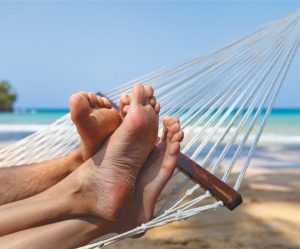 With summer around the corner, it’s time to enjoy a well-deserved vacation. The last thing you or your family needs is a painful or injured foot to ruin you long awaited vacation. Fortunately, there are a few steps you can take to prevent foot and ankle injuries while traveling.
With summer around the corner, it’s time to enjoy a well-deserved vacation. The last thing you or your family needs is a painful or injured foot to ruin you long awaited vacation. Fortunately, there are a few steps you can take to prevent foot and ankle injuries while traveling.
1. Wear comfortable shoes while traveling, whether it’s for a long car drive or to the airport. You never know how far you may have to walk while at the airport or if you are running later for a connecting flight that might require you to walk fast or run to your terminal. Loose-fitting flip-flops and sandals increase your risk of tripping, falling and spraining your ankle. It can also lead to heel pain without a proper arch support.
2. Socks are your friend. Socks protect your feet from shoe friction/rubbing that can lead to blisters and painful callosities. You may be required to remove your shoes before you enter the metal detectors at airports. Walking barefoot through an airport exposes your feet to bacteria and viruses that could cause plantar warts and athlete’s foot so don’t skip on the sock while traveling.
3. Don’t bring brand new shoes on vacation. Shoes that you have never worn can cause pain, blisters and other complications. Make sure to use shoes you know are comfortable while traveling especially if you will be on your feet for an extended period of time. It’s also important to not use old or excessively worn down shoes.
4. Don’t forget your children’s shoes. Make sure their shoes fit properly and are comfortable as well.
5. Flip-flops or sandals are useful during certain situations. Use them in place of walking barefoot in locker rooms and around pools. Walking barefoot at these areas increases your risk of acquiring athlete’s foot, plantar warts and toenail fungus. Today, it also common to find ones with built in arch supports. These are more ideal than a flat flip flop or sandal.
6. Pack an antifungal cream or powder. If you’re staying in a hotel or using public pools, using an antifungal product can help prevent athlete’s foot.
7. Place a towel on the floor before entering the shower or bathtub. This can prevent slipping.
8. Stretching is your friends. If you are traveling more than two hours, be sure to stretch your legs and pump your feet. This will help circulate the blood to prevent deep vein thrombosis, aka dangerous blood clots in the legs.
9. Compression socks can be helpful on flights. Compression socks can help prevent with edema or swelling of the legs while traveling. Long car rides and flying can make your swelling worse, if you suffer from lower extremity edema you should definitely use compression socks while traveling. Arriving at your destination with worsening edema can cause you pain, make it hard to fit in your shoes and make your vacation experience less desirable.
10. Pack a small first-aid kit. If you develop blisters, small cuts or abrasions a first aid kit can come in handy. Clean your feet with saline (eye solution), avoid peroxide than apply a small amount of antibiotic ointment and cover with a Band-Aid or gauze. If a puncture wound occurs, see a foot and ankle surgeon within 24 hours for to prevent infections and other complications.
Isin Mustafa DPM, MSHS, AACFAS
For more information, you may contact Dr. Isin Mustafa at Family Foot & Leg Center at (239) 430 – 3668 (FOOT). Family Foot & Leg Center has 8 locations throughout Collier, Lee, & Charlotte Counties to quickly resolve all your foot
and ankle problems.
3161 Harbor Blvd, Suite B
Port Charlotte, FL 33952
(239) 430 – 3668 (FOOT)
www.NaplesPodiatrist.com








